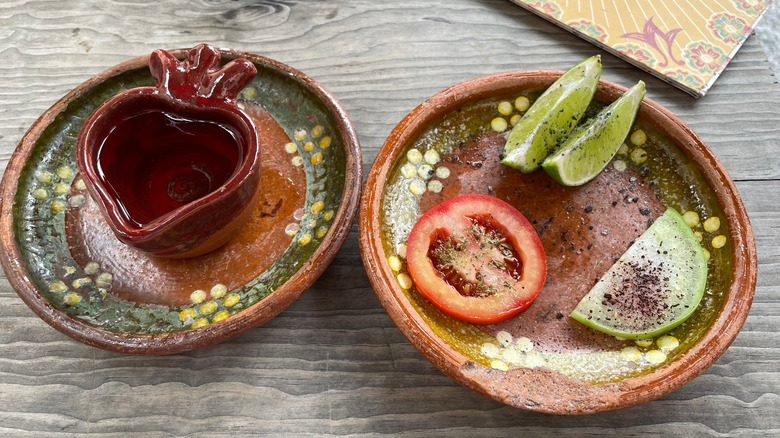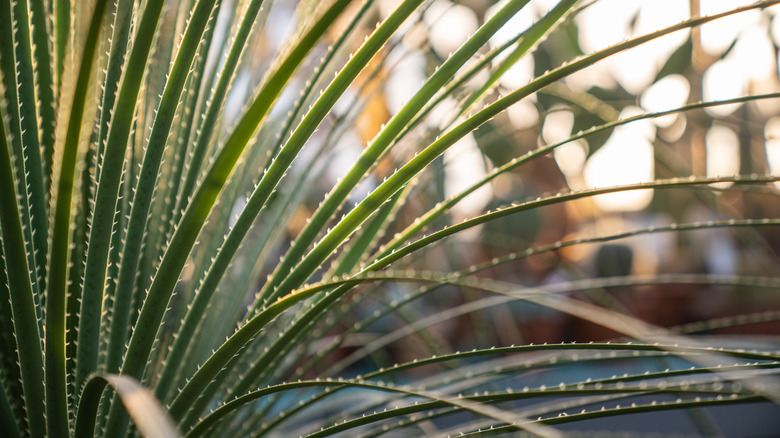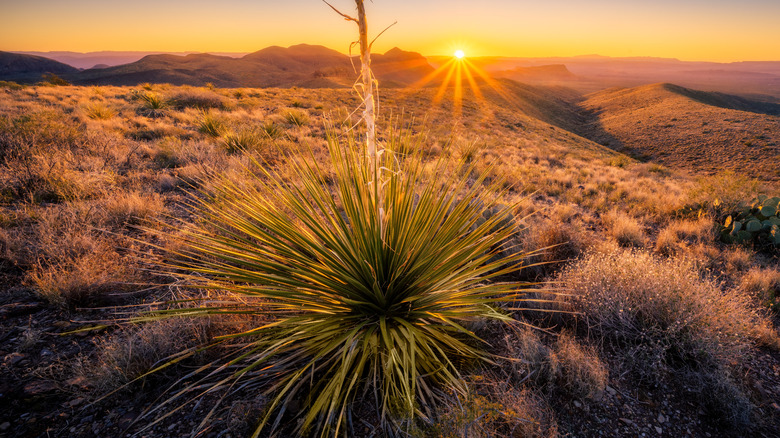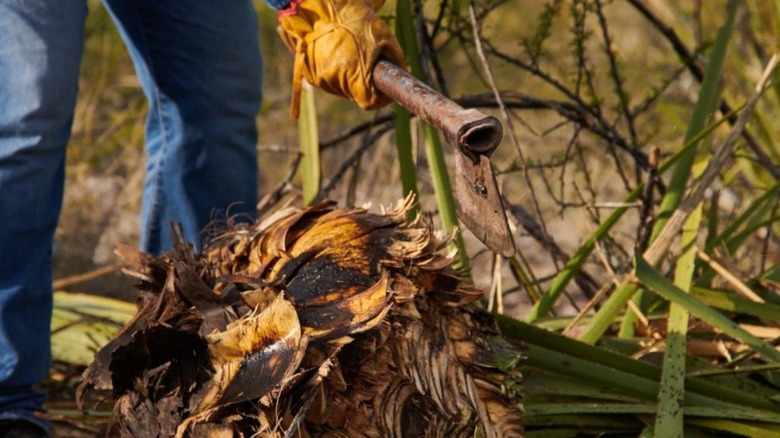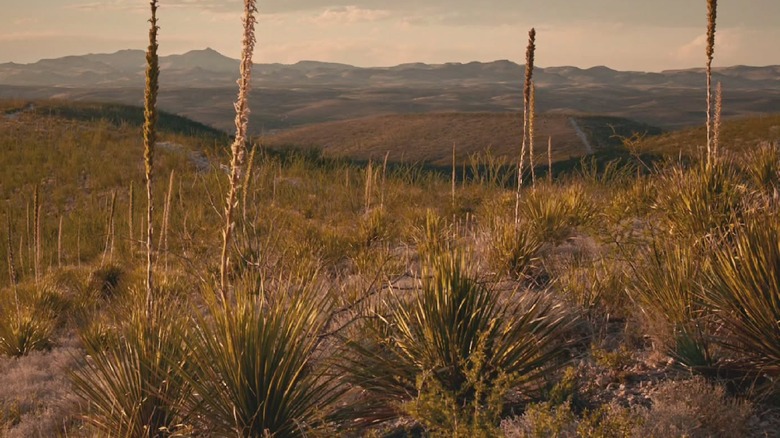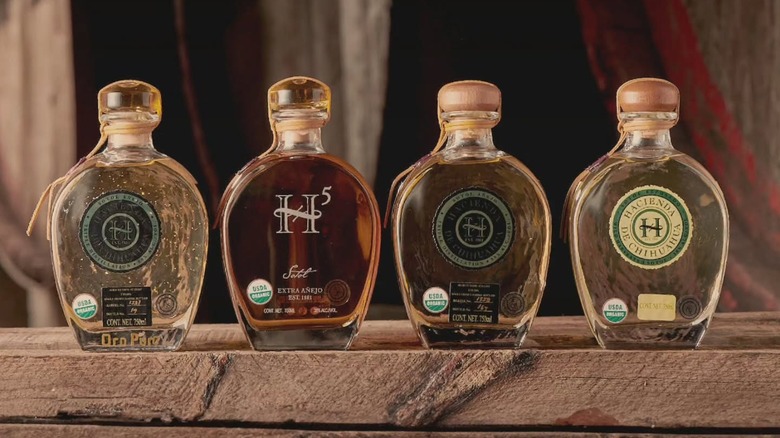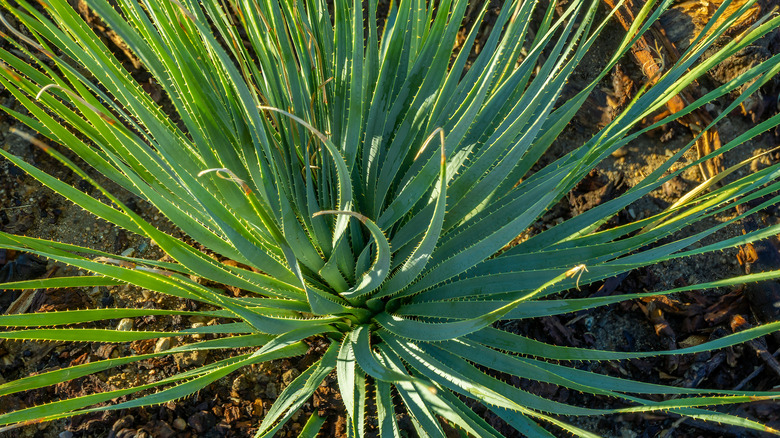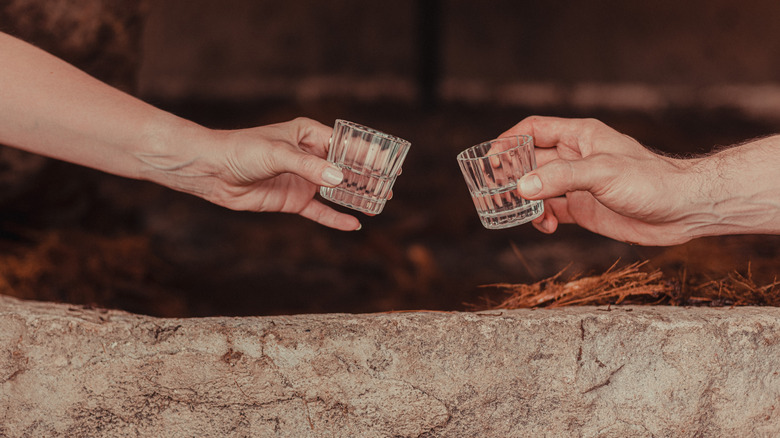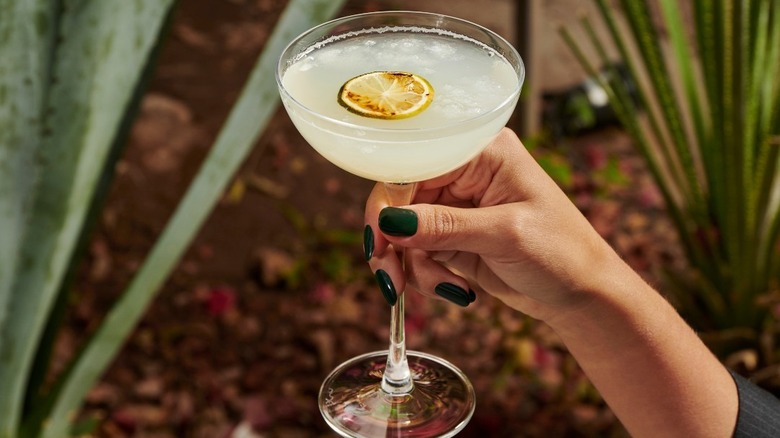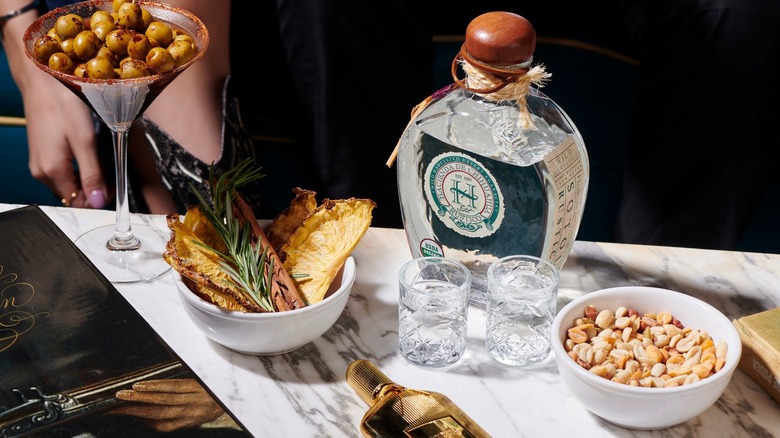Everything You Need To Know About Sotol, Mexico's Most Underrated Spirit
On the subject of Mexican spirits, tequila and mezcal are by far the most well-known. However, they're not the only ones worth sipping. Sotol is a spirit that's been making waves in mixologist circles as of late thanks to its unique grassy, mineral character that speaks to the desert environment where it's produced. Unlike tequila and mezcal, which are made from agave, sotol is made from a hardy plant native to Northern Mexico and parts of the Southwestern United States. It's a spirit that's deeply ingrained in the culture of Chihuahua and other desert states, and it's just starting to get the attention it deserves on the international spirits scene.
To learn more about what sets sotol apart from other Mexican spirits, we spoke with the team at Hacienda de Chihuahua, one of the leading producers of the spirit. The family-run company was founded in 1996 by the Eliás Madero family, and its center of operations is the historic Hacienda Tabalopa, which started distilling sotol in 1881.
The Hacienda de Chihuahua team walked us through the basics including where it comes from, how it's made, and what makes it stand out in a crowded spirits market. If you love tequila and mezcal but want to try something with a unique twist, then sotol will be right up your alley. Here's everything you need to know about this distinctive spirit.
What is sotol?
Take a sip of sotol and you could be forgiven for thinking that it's in the family of agave spirits like tequila, mezcal, raicilla, and bacanora. However, as mentioned, sotol comes from a different plant altogether. It's made from a spiky shrub-like plant called Dasylirion, known as desert spoon or sotol. There are numerous varieties of Dasylirion, but the one most commonly used to make sotol is Dasylirion wheeleri. Other varieties sometimes used for sotol include Dasylrion leiophyllum and Dasylirion cedrosanum.
The Dasylirion plant is native to the Chihuahuan Desert, which spans the Mexican states of Chihuahua, Durango, Coahuila, and Nuevo León, as well as parts of Texas, Arizona, and New Mexico. It's a hardy plant that can withstand extreme hot and cold temperatures and drought. The plant has long grey-green leaves with small spikes on the outer edges. It also grows a stalk vertically from the center that blooms with small yellow or whiteish flowers. The flower stalks can reach heights of 15 feet.
The core of the Dasylirion plant and the flowers are edible, although it's the heart of the plant (aka the piña) that's typically used to make sotol. The spirit is made by fermenting and distilling the juice of the Dasylirion piña. The result is a strong, clear spirit that has an ABV of anywhere between 35% and 55%.
Sotol's intriguing history
Sotol may be new to many mixologists, but it has a history that dates back roughly 800 years. As the Hacienda de Chihuahua team explained, "Indigenous communities like the Rarámuri used the sotol plant for ceremonial and nutritional purposes long before distillation was introduced. Over time, this evolved into informal distillation practices in rural areas, often passed down through generations." When the Spanish arrived in the 16th century, they introduced modern distillation methods and that's when sotol took on the form we know today.
The reason that sotol has remained relatively obscure while other Mexican liquors like tequila rose to international fame is deeply tied to politics. When Prohibition took effect in the United States in 1920, whisky and brandy distilleries began popping up in border towns. People in power with a vested interest in the distilleries and production of tequila began pushing the narrative that sotol was backwater moonshine. In 1944, sotol production was legally banned and sotoleros (sotol producers) were openly persecuted.
Despite the ban on sotol, many sotoleros continued to ply their craft in secret. As the Hacienda de Chihuahua team said, "The connection to local culture is deep — sotol has always been shaped by the desert and intimately tied to the traditions and ways of life of the people who live there." When the ban on sotol was finally lifted in 1994, it sparked a passion in many producers to finally realize the spirit's potential.
How is sotol made?
If you're familiar with how tequila is made, then you'll find a lot of similarities in sotol production. However, there are slight differences. One is that the majority of sotol is made from wild Dasylirion plants. While tequila producers often source domestic agave grown in commercial fields, sotoleros go to the desert to track down Dasylirion plants. In addition, Dasylirion plants take between eight to 22 years to mature, as opposed to the five to seven years it takes agave plants to mature.
Once the Dasylirion piñas are hand-harvested, they're taken back to the vinatas (distilleries) and either steamed or roasted in pits. Then they're chopped or shredded into fibers and pressed to extract the juice, which is called mosto. The mosto is fermented and then distilled at least two times, although some producers distill it a third time for good measure. One way sotoleros check the alcohol content is by pouring the spirit back and forth between cow horns and checking the bubbles (aka "pearls").
Techniques vary among sotoleros and vinatas. For example, the Hacienda de Chihuahua team told us, "We cook the plants using steam-based hydrolysis with indirect heat, which avoids the smoky flavor found in some artisanal methods. After cooking, we rehydrate the fiber to extract sugars more effectively, then ferment with wine and champagne yeasts for cleaner, more refined flavor profiles. Double distillation in column stills ensures consistency and purity."
The Domination of Origin
Once sotol became legal in the 1990s, one of the first things Hacienda de Chihuahua pushed for was to achieve a Denomination of Origin (DO) for the spirit. The DO is a designation that states a product comes from a specific geographic area and adheres to a set of standards. It's the reason Scotch can only be made in Scotland, only French cognac can truly be called cognac, and tequila can only come from Mexico.
In 2022, sotol was officially granted Denomination of Origin status thanks in large part to Hacienda de Chihuahua's efforts. "This marked a turning point for sotol," explained the team. "It provided a framework to protect the heritage and ensure the quality of the spirit, while placing it alongside tequila and mezcal as a recognized Mexican denomination. It also encouraged producers to elevate their standards and opened doors for sotol to gain global recognition."
According to the DO status, sotol can only be produced in the Mexican states of Chihuahua, Durango, and Coahuila. The area that the sotol DO covers encompasses roughly 52.4 million hectares, which is more than other DO areas around the world. For example, the land covered under the DO for tequila is 11 million hectares, and the DO area for Scotch clocks in at eight million hectares.
The controversy over who can produce sotol
While the Denomination of Origin status for sotol was a significant win for many producers, it caused some controversy because not everyone agrees on what should count as "real" sotol, or who should be allowed to make it. In Mexico, only a handful of states are legally allowed to produce sotol, but cross the border into the U.S. and the rules start to blur. There you'll find some producers crafting their versions of the spirit, with or without Mexico's blessing.
In 1994, the United States agreed to recognize the DO status of tequila and mezcal under the North American Free Trade Agreement. In 2020, the NAFTA agreement was replaced with the US-Mexico-Canada Agreement. Early drafts of that agreement included DO recognition for sotol. However, that went out the window when a Texas senator intervened, claiming it would harm the Texas sotol industry. That's why you can also find American brands of sotol.
For many Mexican producers, sotol is a part of their heritage. There's concern that outside producers muddy the category and potentially undercut the hard-earned reputation of traditional sotol. On the other hand, some argue that outside production helps raise awareness and demand for the spirit overall. It's a layered debate that mirrors similar conversations in the world of mezcal and tequila, where tradition, geography, creative license, and commercial interests often collide.
Is sotol a sustainable spirit?
It's no secret that the global thirst for tequila and mezcal has skyrocketed in recent years, and that surge in demand has brought some serious sustainability challenges. Agave plants can only be harvested once, as the process involves uprooting the entire plant. Replanting isn't a quick fix because agaves take several years to mature. As a result, keeping up with demand often means pushing cultivation into overdrive, which can lead to habitat destruction and reduced biodiversity.
So far, sotol producers have managed to avoid some of the problems that tequila and mezcal producers find themselves up against. For one, sotol is mostly produced on a smaller, more traditional scale. Many producers use artisanal methods and produce small batches. In addition, many larger producers are mindful about how they harvest the wild Dasylirion plants. Some, like Hacienda de Chihuahua, remove the piñas, but leave the roots intact so the plants can regenerate.
The Mexican government is also playing a role in sotol's sustainability. For one, producers must have a permit to harvest Dasylirion plants. Furthermore, the government decrees how many plants can be harvested in a particular area. Still, as interest in sotol continues to grow, many producers and environmental advocates agree that proactive conservation efforts will be key to keeping the spirit sustainable in the long run.
What does sotol taste like?
While many people compare the taste of sotol to tequila and mezcal, it's not quite the same. According to the Hacienda de Chihuahua team, "Sotol is shaped by its environment in a way few spirits are. The Chihuahuan Desert — with its extreme temperatures, dry winds, and dramatic elevation — imprints the plant with a bold, earthy character. Unlike agave spirits, which tend to be fruitier and sweeter, sotol is more herbaceous, mineral, and complex."
In addition, the taste of sotol can be different depending on where the plants grow. For example, plants that grow in forested areas can give notes of pine and fresh herbs while plants that grow in drier areas can offer hints of pepper with a distinct minerality. The production methods can also change the flavor. Steaming the piñas can give sweeter notes while roasting them will provide a smoky element to the sotol.
Some sotol producers also offer expressions aged in oak casks that can change the flavor. For example, a reposado sotol aged for a few months might have slight vanilla and butterscotch notes, while an añejo sotol aged for a year or longer can be smooth and rich with hints of chocolate and leather. Hacienda de Chihuahua also makes cream-based sotol liqueurs, one flavored with chocolate and another with nuts. Like tequila or mezcal, sotol varies in taste depending on the producer and expression.
What sets sotol apart from other Mexican spirits?
What really sets sotol apart from other spirits isn't just the plant it comes from or how it's made. It's the way it fits into the drinking landscape. Sotol doesn't have the same mainstream recognition as tequila or the cult-like following of mezcal, which gives it a certain freedom. It doesn't slot neatly into any category. Instead, it can be smoky like mezcal, grassy like some gins, and a unique earthiness. Bartenders love that it's versatile and brings something unexpected to cocktails.
There's also something to be said for sotol's sense of place. It reflects the high desert regions of northern Mexico in a way that feels honest and unpolished. While many big-name spirits have leaned into slick marketing and celebrity tie-ins, sotol still feels personal. As the experts at Hacienda de Chihuahua said, "It's also less known internationally, which makes it a discovery — a hidden gem that invites curiosity." In a market crowded with loud bottles and mass-produced spirits, sotol stands out for being quietly distinct.
How to drink sotol
When we asked the folks at Hacienda de Chihuahua if there is a correct way to drink sotol, they told us, "Traditionally, sotol was sipped neat, often at room temperature, to appreciate its full character." However, they were also quick to point out that sotol is incredibly versatile and can shine in cocktails, especially when paired with citrus, herbs, or dry ingredients that enhance its savory profile. They suggested shaking up a sotol martini or putting an earthy twist on a Negroni. "Its dry, clean finish also works beautifully in highballs or spritz-style drinks," they added.
Given that sotol is a Mexican spirit, it is no surprise that it works beautifully in traditional Mexican cocktails like margaritas. You can go with the classic lime version, or try creative margarita flavors that aren't lime like mango, blood orange, or hibiscus. You can also try sotol in a paloma with lime juice and grapefruit soda, or create a fizzy cantarito cocktail with sotol, grapefruit soda, orange juice, grapefruit juice, and a spicy Tajín rim. Don't be afraid to play around with new flavors. Sotol pairs well with a wide range of ingredients.
What to look for when buying sotol
As sotol gains ever-increasing recognition in Mexico and abroad, more producers are popping up and new expressions are hitting the market every year. If you're new to sotol, it can be difficult to know which ones are worth picking up. While everyone's tastes are different, there are a few things that can indicate that the bottle you're purchasing is legit.
The first thing to look for in an authentic bottle of Mexican sotol is a NOM. Just like all tequila bottles have a NOM, so too do bottles of sotol. It stands for Norma Oficial Mexicana and it's a code that the Mexican government assigns to indicate that the product is authentic and adheres to certain standards. For sotol, it's NOM-159-SCFI-2004 and it ensures that the spirit comes from the designated DO area and that at least 51% of the sugars come from the Dasylirion plant.
If you can, do a quick search on the brand. Producers with roots in the region — especially those based in Chihuahua, Coahuila, or Durango — are likely to have a deep connection to the spirit. Bonus points if they talk about sustainability or wild harvesting practices.
